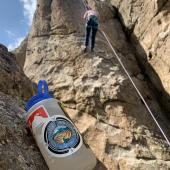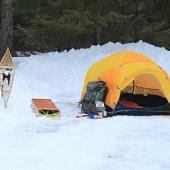Alpine Adventures
 Bozeman's Inaugural International Mountain Day
Bozeman's Inaugural International Mountain Day
In Bozeman during winter, it’s impossible to not be overcome by the vision of a freshly powdered peak as the clouds lift over the Bridgers. Or if you are one of the few people in Bozeman who doesn’t ski or snowboard, you gaze longingly at the mountains and count down the days until the snow melts so you can start your summer peak-bagging list.
Whatever your favorite season may be, mountains play an undeniably large role in Bozeman life. So it only seems fitting for MSU to partner with local organizations to host Bozeman’s inaugural celebration of International Mountain Day this past Tuesday at the Emerson Center.
International Mountain Day (IMD) is a UN-designated day hosted all around the world for the past decade. It was created to raise awareness about the critical role that mountains play in our planet’s ecosystem, but until this year Bozeman had never hosted one of its own.
The event was an opportunity for local nonprofits with connections to the outdoors and conservation to set up display booths and gain face time with the public. There were long-time Bozeman nonprofits represented, such as the Gallatin Valley Land Trust and the Montana Outdoor Science School. There were also organizations most Bozemanites were unfamiliar with, such as the Wilderness Rec Partnership, the Absaroka/Beartooth Wilderness Foundation, and the Montana Wilderness Society.
Aside from showcasing local environmental groups, the focal point was the Everest Educational Expedition 2012, which was developed in large part by MSU Extended University. The three speakers of the night were all members of the Everest Educational Expedition: MSU Professor of Structural Geology David Lageson, MSU geology graduate student Travis Corthouts, and Bozeman mountaineer Conrad Anker.
Lageson spoke first, presenting with unbridled enthusiasm about the geological creation and composition of Everest. He was followed by Corthouts, who showed helmet-cam footage from the expedition featuring a rickety ladder traverse over a yawning crevasse.

Anker, who played a key role in developing the expedition, focused primarily on the environmental situation at hand. The 2012 expedition was Anker’s third ascent of the peak. “Everest has been climbed,” he said. “How do you make it relevant?” Anker went on to cite the importance of the expedition as fuel for a connection between science and adventure to the students around the world who followed it from start to finish. He spoke at length about how mountains are affected by a dynamic climate and the unavoidable truth of how climate change affects glaciers and mountain habitats.
In lieu of speaker fees, Lageson and Anker asked that audience members drop a donation in collection buckets for the nonprofit organizations Everest ER and Khumbu Climbing Center. For more information, or to see how you can help, visit everester.org and alexlowe.org/kcs.shtml.
Check out these local nonprofits and see how you can get involved:
Montana Outdoor Science School: outdoorscience.org
Gallatin Valley Land Trust: gvlt.org
Wilderness Rec Partnership: gallatinwrp.org
Absoroka/Beartooth Wilderness Foundation: abwilderness.org
Montana Wilderness Society: wildmontana.org









